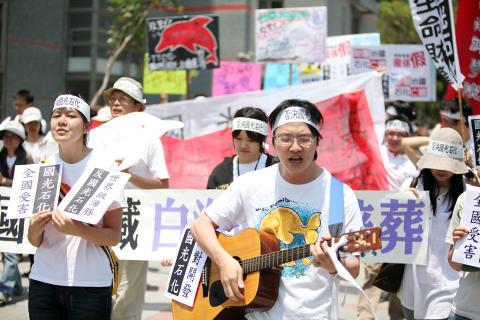The environmental impact assessment (EIA) procedure needs to be overhauled so that controversial projects can be reviewed more thoroughly and political responsibility is more clearly defined, environmentalists said yesterday.
The Environmental Protection Administration (EPA) today will hold its fifth EIA meeting related to a controversial petrochemical project planned by Kuokuang Petrochemical Technology Co for a wetlands area in Changhua County.
Environmental activists have criticized the EIA process, calling its as flawed.

Photo: CNA
Chen Ping-hsuan (陳平軒), spokesperson of the National Youth Alliance Against Kuokuang Petrochemical Project, said members of the EIA committee reviewing the project had come under excessive political pressure because they had the power to veto the project.
Chen said the final decision on the project should not be made based solely on the EPA’s judgment. Instead, the Executive Yuan should convene interdepartmental meetings to weigh a wide range of issues, from environmental protection to economic development.
“It is the Executive Yuan, not the EPA, that should be the gatekeeper of the review process so we know who can be held substantively responsible for the decision,” he said.
Such a broad review was necessary for projects such as the Kuokuang petrochemical complex plan because they could have a substantial impact on all government branches, far beyond the reach of the EPA, the activist said.
Chen also worried that because the EPA has been given de facto veto power by politicians, the EIA committee members would be forced to consider “political issues that are not related to their expertise” because they do not want to upset the authorities.
Chen said the EIA process should rely on more formal formats, such as administrative hearings, rather than the semi-public meetings used at present where comments by committee members are not a matter of public record.
The government has suggested conducting an EIA for the country’s petrochemical industry policy as a whole, an idea that Chao Chia-wei, the coordinator of the Green Citizens’ Action Alliance, believes would be a step forward.
However, he said it should take place before the authorities decided whether to give a nod to the Kuokuang project.

SHIPS, TRAINS AND AUTOMOBILES: The ministry has announced changes to varied transportation industries taking effect soon, with a number of effects for passengers Beginning next month, the post office is canceling signature upon delivery and written inquiry services for international registered small packets in accordance with the new policy of the Universal Postal Union, the Ministry of Transportation and Communications said yesterday. The new policy does not apply to packets that are to be delivered to China, the ministry said. Senders of international registered small packets would receive a NT$10 rebate on postage if the packets are sent from Jan. 1 to March 31, it added. The ministry said that three other policies are also scheduled to take effect next month. International cruise ship operators

NUMBERS IMBALANCE: More than 4 million Taiwanese have visited China this year, while only about half a million Chinese have visited here Beijing has yet to respond to Taiwan’s requests for negotiation over matters related to the recovery of cross-strait tourism, the Tourism Administration said yesterday. Taiwan’s tourism authority issued the statement after Chinese-language daily the China Times reported yesterday that the government’s policy of banning group tours to China does not stop Taiwanese from visiting the country. As of October, more than 4.2 million had traveled to China this year, exceeding last year. Beijing estimated the number of Taiwanese tourists in China could reach 4.5 million this year. By contrast, only 500,000 Chinese tourists are expected in Taiwan, the report said. The report

The Forestry and Nature Conservation Agency yesterday launched a gift box to market honey “certified by a Formosan black bear” in appreciation of a beekeeper’s amicable interaction with a honey-thieving bear. Beekeeper Chih Ming-chen (池明鎮) in January inspected his bee farm in Hualien County’s Jhuosi Township (卓溪) and found that more than 20 beehives had been destroyed and many hives were eaten, with bear droppings and paw prints near the destroyed hives, the agency said. Chih returned to the farm to move the remaining beehives away that evening when he encountered a Formosan black bear only 20m away, the agency said. The bear

HORROR STORIES: One victim recounted not realizing they had been stabbed and seeing people bleeding, while another recalled breaking down in tears after fleeing A man on Friday died after he tried to fight the knife-wielding suspect who went on a stabbing spree near two of Taipei’s busiest metro stations, Taipei Mayor Chiang Wan-an (蔣萬安) said. The 57-year-old man, identified by his family name, Yu (余), encountered the suspect at Exit M7 of Taipei Main Station and immediately tried to stop him, but was fatally wounded and later died, Chiang said, calling the incident “heartbreaking.” Yu’s family would receive at least NT$5 million (US$158,584) in compensation through the Taipei Rapid Transit Corp’s (TRTC) insurance coverage, he said after convening an emergency security response meeting yesterday morning. National